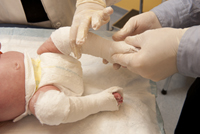Ideally, treatment for vertical talus is started as soon as possible after birth. The treatment of vertical talus has evolved over the last decade to a minimally-invasive approach that utilizes primarily serial manipulation and casting to achieve correction. This approach eliminates the need for more extensive surgery while still providing excellent correction.
Treatment Plan
Stretching and serial casting

Initial treatment of vertical talus consists of gentle manipulation of the foot to stretch the contracted tissues. The doctor will stretch the child's foot into the desired amount of correction and apply a plaster cast in two sections, paying careful attention on the molding of the foot and ankle. Most of the treatment takes place in the doctor's office. This phase generally requires four to six plaster casts that are changed weekly in the office.
Surgical intervention
Once the foot is corrected with casting, the child is scheduled for a minimally-invasive surgical procedure to insert a temporary pin to hold the bones of the foot in proper alignment. At the same time, a percutaneous (without skin incision) heel cord tenotomy is performed to correct the tightness that remains in the ankle. After surgery, the child's foot is placed into a long leg cast for two weeks. When this cast is removed, the child will be measured for a special brace. At the same visit, a new long leg cast is applied and worn for four additional weeks. This cast will be removed in the operating room along with the pin.
Bracing
After the last cast is removed, the child will then begin wearing a brace (foot abduction orthosis) designed to prevent the vertical talus deformity from recurring. The brace consists of a custom-molded insert with an AFO (ankle foot orthosis). The brace is used to treat both clubfoot and vertical talus.
For more information on the treatment of vertical talus or to make an appointment, please call us at 314.454.5437 or 800.678.5437.










